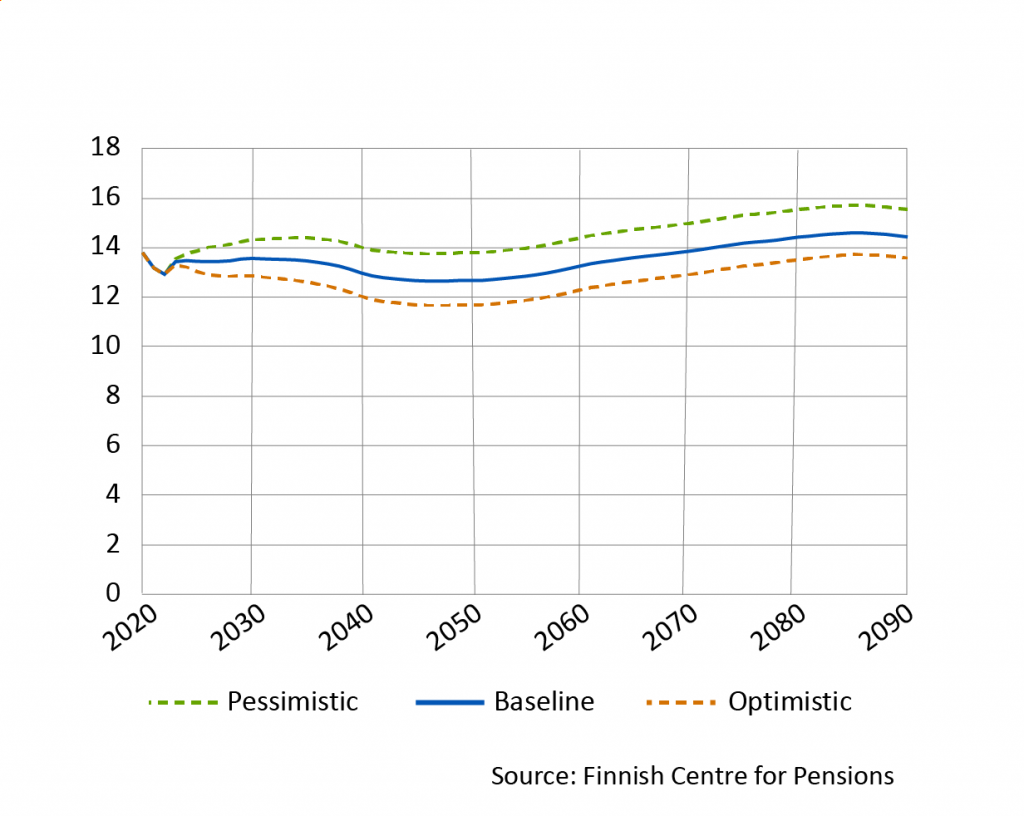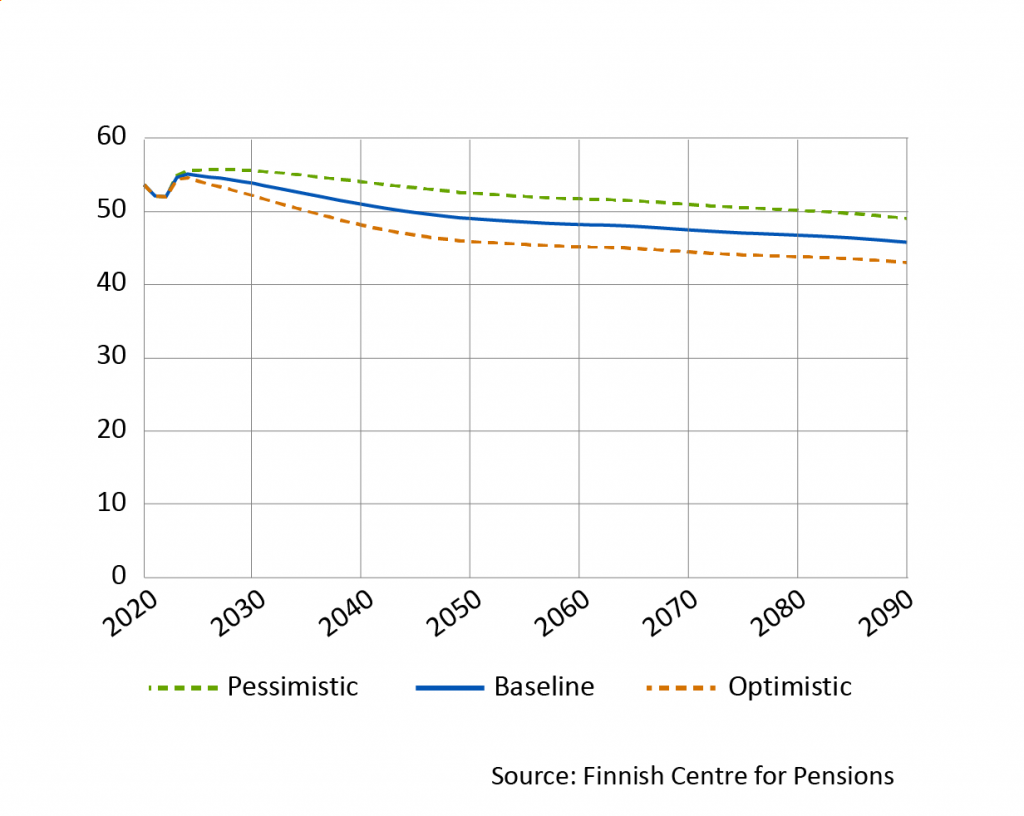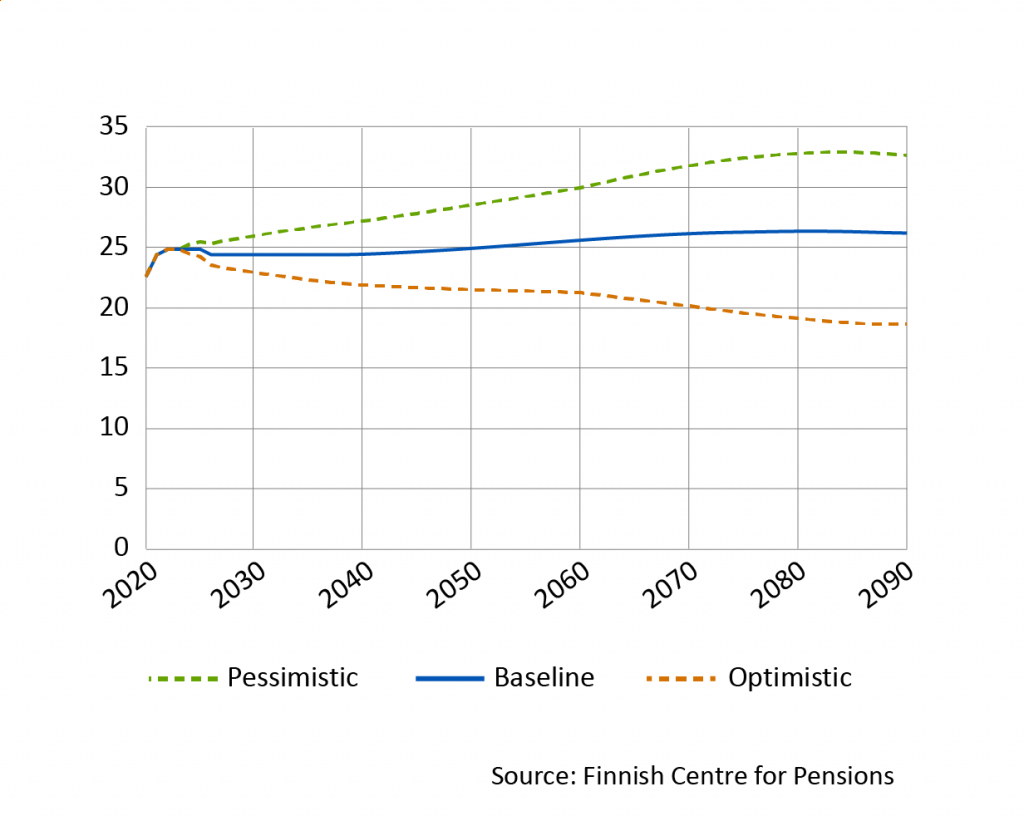Latest Projections
Population projection, age limits and life expectancy coefficient
The long-term projections are based on the 2021 population forecast of Statistics Finland. However, the starting level of mortality takes into account the preliminary data on the exceptionally high mortality rates in 2021 and early 2022. At year-end 2021, the population in Finland numbered 5.55 million. It is expected to decrease to 5.1 million by 2090.
For those born in 1955 or later, the retirement age will rise by 3 months per age cohort until it is 65 years for those born in 1962. For those born in 1965 or later, the retirement age is linked to the development of the life expectancy coefficient. The amount of the old-age pension is adjusted with the life expectancy coefficient based on changes in the expected life expectancy of retirees. The life expectancy coefficient is confirmed for each age cohort at the age of 62. In 2030, the value of the life expectancy coefficient will be 0.93 and in 2090 it will be 0.86. A target retirement age is determined for each age cohort. If retirement is deferred until the target retirement age, the increment for late retirement will be at least of the same size as the effects of the life expectancy coefficient. A target retirement age has not been calculated for younger age cohorts since their target retirement age would be higher than the age at which the insurance obligation ends.
Age limits of the earnings-related pension system
| Year of birth | Retirement age | Target retirement age | Age at which insurance obligation ends |
|---|---|---|---|
| 1955 | 63 years 3 months | 64 years 1 month | 68 years |
| 1960 | 64 years 6 months | 65 years 9 months | 69 years |
| 1965 | 65 years 2 months | 66 years 7 months | 70 years |
| 1970 | 65 years 10 months | 67 years 6 months | 70 years |
| 1975 | 66 years 4 months | 68 years 3 months | 70 years |
| 1980 | 66 years 10 months | 69 years | 70 years |
| 1985 | 67 years 4 months | 69 years 8 months | 70 years |
| 1990 | 67 years 9 months | – | 70 years |
| 1995 | 68 years 2 months | – | 70 years |
| 2000 | 68 years 7 months | – | 70 years |
| 2005 | 68 years 11 months | – | 70 years |
Pension expenditure and pension levels
This section shows the development of pension expenditure, pension levels and the contribution under the Employees Pensions Act (TyEL) in three economic scenarios: the baseline, the optimistic and the pessimistic economic scenarios. The alternatives differ in terms of the assumed employment rate, growth of earnings and return on pension assets. Further results and alternative scenarios are presented in the report Statutory pensions – long-term projections 2022 and the Skeneraattori (scenario generator) application (in Finnish).
Employment rate, growth of earnings and return on pension assets in the different scenarios
| Variable | Optimistic | Baseline | Pessimistic |
|---|---|---|---|
| Average employment rate 2023–2090, % | 75.4 | 73.4 | 71.5 |
| Average real growth of earnings 2023–2090, % | 1.71 | 1.16 | 0.62 |
| Real return on pension assets, % | 1.2 percentage points above the baseline projection | 2.5% in 2023–2031, 3.5% as of 2032 | 1.2 percentage points below the baseline projection |
In 2021, the total statutory pension expenditure was 13.2 per cent of GDP. In the baseline projection, the ratio of the total expenditure to GDP will rise to 13.6 per cent in 2030. After 2030, the number or retirees will slowly decrease and the average pensions relative to earnings will fall. These factors result in a decreased pension expenditure relative to GDP. By 2045, the ratio will go down to 12.7 per cent in the baseline projection. From 2050, the average pension relative to the average wage will fall at a slower pace and the number of pension recipients will continue to grow. As a result, the ratio of pension expenditure to GDP will start to grow. This trend will continue during the latter half of the century. At the end of the projection period, in 2090, pension expenditure is 14.4 per cent of GDP in the baseline projection.
In the optimistic scenario, a more rapid economic growth curbs the growth of pension expenditure relative to GDP. By 2045, pension expenditure relative to GDP will fall to 11.7 per cent. In 2090, at the end of the projection period, pension expenditure relative to GDP will stay at 13.6 per cent in the optimistic scenario. In the pessimistic scenario, pension expenditure relative to GDP will rise until the mid-2030s, reaching a level of 14.4 per cent. In the 2040s it will fall to 13.8 per cent and rise again towards the end of the projection period to 15.5 per cent.
During the projection period, the purchasing power of the average pension will continue to rise as a result of an increase in earnings. Following high inflation, a major index increase will be made to pensions at the beginning of 2023. It will increase the average pension relative to average earnings. In 2024, the average pension will be around 55 per cent of the average earnings, after which the ratio will decline in the baseline projection throughout the projection period, ending up at around 46 per cent in 2090. The most important reason for the drop in the relative pension level is the extended life expectancy and the life expectancy coefficient, which adapts the benefit level to correspond to changes in life expectancy.
The purchasing power of pensions is the highest in the optimistic scenario and the lowest in the pessimistic scenario since the earnings-related pension is determined based on earnings. In relation to the general earnings level, the pension level is highest in the pessimistic scenario since the earnings-related pension index and the wage coefficient will lag behind the growth in earnings the least in that scenario.
Statutory pension expenditure, % of GDP

Average pension, % of average wage

TyEL contribution
In the baseline projection, the contribution rate under the Employees Pensions Act (TyEL contribution) will remain below 25 per cent until the year 2050. In the latter half of the century, the TyEL contribution will rise as TyEL pension expenditure grows due to changes in demography. In the baseline projection, the TyEL contribution will be 26.2 per cent of the payroll at the end of the projection period. This will be a sustainable contribution level also after that. In the optimistic scenario, the TyEL contribution will be 2.6 percentage points below the baseline projection by 2040. In the pessimistic scenario, on the other hand, it will rise to 2.8 percentage points above the baseline projection. By 2090, the contribution will be 7.5 percentage points below the baseline projection in the optimistic scenario and 6.4 percentage points above the baseline projection in the pessimistic scenario.
TyEL contribution, % of wages

More on other sites: